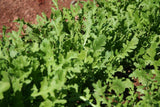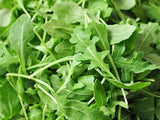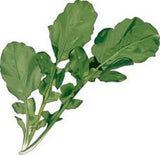Country Creek LLC
Arugula Seeds

Description, Nutritional Value
Arugula is a leafy green veggie with a spicy kick. Offering a pepper-like flavor, arugula leaves are high in nutrients including beta-carotene, vitamin C, folate, and magnesium, all of which are key to helping the body’s organ systems function properly!
Arugula is very low in carbohydrates, offering less than 1 gram per serving. Unlike many of its other cruciferous counterparts, arugula is rather low in fiber per serving. A 2-cup serving of raw arugula would provide closer to 0.8 grams of fiber.
Micronutrients are where arugula really shines. It is high in beta-carotene, vitamin C, folate, vitamin K, and magnesium. Two cups of raw arugula will provide 20% of the body’s daily vitamin A needs, 50% of vitamin K needs, and 8% each of vitamin C, folate, and calcium!
Boosts Bone Health: Because of its high vitamin K content, arugula improves bone health through improved calcium absorption and contributes to the prevention of osteoporosis.
Reduces Diabetes Complications: Leafy green vegetables such as arugula contain alpha-lipoic acid, an antioxidant that may especially benefit people with diabetes. This compound promotes lower glucose levels, increases insulin sensitivity, and prevents oxidative stress-induced changes.
Lowers Heart Disease Risk: A review of several studies on leafy green and cruciferous vegetables found a nearly 16% reduced incidence of cardiovascular disease in people who consumed more of these veggies.
How to Tray Plant
*Start the seeds during early spring or fall: Arugula has the easiest time establishing itself in mildly cool weather. Start the seeds in the early spring or fall so that the temperature is right when you transplant the seedlings to the garden.
*Fill a cell container with rich light potting soil: Get a container with separate cells from a home improvement store or garden center. Make sure that each cell has a drainage hole. Fill each cell most of the way up with a light organic compost soil.
*Plant seeds in the cells: Put one or two seeds in each cell and then sprinkle some more soil on top of the seeds. The seeds should be placed about ¼ inch (6.5 mm) below the surface of the soil.
*Water every other day to keep the soil moist: Initially, it's very important to keep the seeds well watered. It's best to water them every other day, or whenever the top inch (2.5 cm) of soil is dry to the touch.
*Keep the cells inside in the sunlight until the plants sprout:
It's best to keep the cell container inside while you wait for them to sprout. This will keep them from being destroyed by the elements. Place the cell container by a window so that the seeds get enough sunlight or use a standard grow light or incandescent light bulb for extra light.

How to Serve
While there’s nothing wrong with eating plain arugula, most people prefer to eat it combined with other foods due to its slightly spicy, peppery flavor.
Try a new take on a Caesar salad with arugula, pecorino cheese, lemon juice, and Italian dressing as your ingredients. You could add tomato and green onion as well, and/or mix in other types of lettuce for variety.
Another popular salad combo is arugula, other mixed greens, dried cranberries, blue cheese, and walnuts.
You can also use arugula in place of lettuce in sandwiches or sautéed and mixed into pasta dishes.
Arugula is also used in pasta sauces and to top pizzas hot from the oven with sharp cheese like Parmesan or soft cheese like burrata.
The leaves can also be stirred into soups, folded in grain dishes like farro and kamut, made into a flavorful pesto or wilted to serve as a bed for roasted or grilled meat, fish and poultry.


Origin
All seeds are grown and packaged in the U.S. Our seed is 100% untreated to ensure that they are safe to eat right out of the garden or kitchen.

Germination
All seeds lots are tested for germination.

Sprouter
These seeds work great with any type of sprouter!
Subscribe for newsletter
A supporting statement for your value proposition to encourage customer to complete your CTAs










